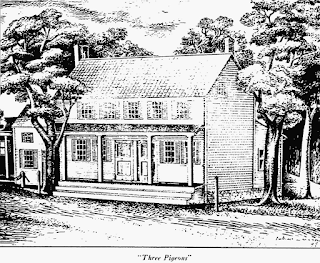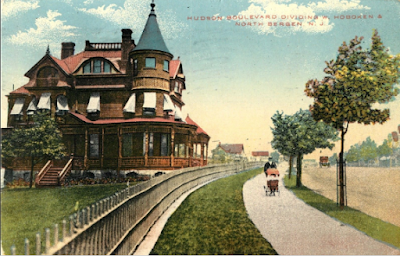"The Frenchman's Garden"
A tale often retold about North Bergen's history is that of Le Jardin du Français or for those none French speaking readers, The Frenchman's Garden. The garden itself was never seen by any North Bergenite, current or even those we'd consider "old timers." Even people considered old timers by today's old timers would not have even laid eyes on the work of André Michaux and Pierre-Paul Saunier. The last remnants of the garden today is occupied by Machpelah & Hoboken Cemetery and those interned there. The tale is one full of interesting characters, events and human interest. From Marquis de Lafayette & King Louis the XVI, to the role of the French Revolution and the lives of immigrants in a foreign land.
Three Pigeon's Inn
Walter Eickmann's History of West New York
The story of The Frenchman's Garden finds its origins during the American Revolution. The young French lieutenant, Marie-Joseph Paul Yves Roch Gilbert du Motier, or better known in the United States as Marquis de Lafayette was meeting with the likes of General George Washington, Nathanial Greene, "Light Horse" Harry Lee, "Mad" Anthony Wayne among other Continental Army leaders. They were to meet at the infamous - and lost to history - Three Pigeons Inn. The inn was located in the area of today's Six Corners Neighborhood. Nevertheless, after a meeting, Marquis de Lafayette was shown a parcel of land known as Maisland. He then in turn contacted King Louis the XVI and told him of a great tract of land, fine for production of flora to grace the majestic gardens of France. In 1785 André Michaux arrived in New York City to establish King Louis first garden in the United States.
"from simple farmer to have a name among learned men."
-Lafayette on Michaux
Courtesy of The St. Augustine Record
-Lafayette on Michaux
Courtesy of The St. Augustine Record
Michuax arrived in the United States with a simple mission, research the woodlands of America for species of trees to rebuild and strengthen the forests of France. The reason for such a mission is simple, France was a leading world power at the time and had stripped the best timbers from its homeland and colonies, it was time to rebuild. On the word of Lafayette, he was pointed to Bergen Woods, present day North Bergen. Michaux purchased 30 acres within the first months of his arrival. The land stretched from Kennedy Boulevard to the Hackensack River and would be nestled between present-day 63rd and 51st Streets. However, Michaux´s time in North Bergen would be brief. The Botaniste du Roi or King's Botanist's time in North Bergen were of great struggle. Learning not just the landscape and flora, but the language as well. Michaux would venture beyond his Bergen Woods arboretum and eventually make his way to Charleston, South Carolina. There he'd establish a second garden, a massive 111 acre nursery.
Andre Michuax Mural Charlestown Airport
by Karl Beckwith Smith
After Michaux's departure, the garden was left in the hands of Pierre-Paul Saunier. Saunier was as accomplished botanist as Michaux and was even tasked by him to continue his work in North Bergen. Poor Saunier faced a series of trials and hard times upon arrival. He spoke no English and was often come over with fits of depression from the solitude he faced in the garden. His newfound loneliness coupled with his wages being paid very far apart, the young gardener could not adjust to his new life in America. Michaux petitioned for a raise in Saunier's wages, hopeful that a larger reward for his work would help the young man. Unfortunately for Saunier the French Revolution had begun and funds from France came to an end as the French neglected their foreign investments. It was during this time that Michaux and Saunier had a falling out as Saunier had taken over the garden and would use it to grow his own food and use his produce as a source of income.
La Liberté guidant le peuple
Eugène Delacroix
The end of the French Revolution not only lead to independence for France, but for Pierre-Paul Saunier. During the Revolution, Michuax contacted officials about Saunier's use of the garden, but those calls went unanswered. After the Revolution Saunier was able to buy a portion of the garden, and eventually given the remaining land as reparations for back pay, and establish his own farm. Saunier tried to keep an economic relationship with his motherland by continuing to send shipments from his farm to the gardens of France. Saunier started his family in North Bergen by marrying Margaret Ackermann and having 4 children. Saunier shared his knowledge of horticulture with the growing population of North Bergen, helping to establish farms in New Durham and up and down Tonnelle Avenue. The garden has two closure dates, the first in 1807 when it was removed as a government institution. In between then and 1830, its official closing date, the Saunier family operated the garden. Saunier departed from this world in 1818 and his eldest son Michael would continue to run the garden. During this time he would send the last shipment of plants to France in 1830. Michael expanded the garden to 137 acres, mainly along Tonnelle Avenue close to the New Durham neighborhood. Michael eventually passed away in 1844. Shortly after, the garden was subdivided and sold off at auction.
Castanea pumila
Courtesy of the Ozark Chinquapin Foundation
Alas The Frenchman's Garden has been long erased from the landscape of North Bergen. Today, what once was this thriving garden is now Machpelah & Hoboken Cemetery, among warehouses, railroads, and finally marshland butting up to the Cromahill Creek. There is no marker, unlike the Charleston counterpart, this landmark has no markers of what once was. The only indication that a garden ever existed there is from the plant life that was cultivated there. Saunier's claim to botanical fame is the Catalpa bignonioides (Bean tree) and Castanea pumila (Chinquapin) featured in the above image. At one time these and several other plants took root in the soils of North Bergen and over the past centuries have spread across the United States as well as the world. None of which would have been possible without the work in North Bergen of two Frenchmen, Michuax and Saunier.
Andre Michuax Mural Charlestown Airport
by Karl Beckwith Smith
After Michaux's departure, the garden was left in the hands of Pierre-Paul Saunier. Saunier was as accomplished botanist as Michaux and was even tasked by him to continue his work in North Bergen. Poor Saunier faced a series of trials and hard times upon arrival. He spoke no English and was often come over with fits of depression from the solitude he faced in the garden. His newfound loneliness coupled with his wages being paid very far apart, the young gardener could not adjust to his new life in America. Michaux petitioned for a raise in Saunier's wages, hopeful that a larger reward for his work would help the young man. Unfortunately for Saunier the French Revolution had begun and funds from France came to an end as the French neglected their foreign investments. It was during this time that Michaux and Saunier had a falling out as Saunier had taken over the garden and would use it to grow his own food and use his produce as a source of income.
La Liberté guidant le peuple
Eugène Delacroix
The end of the French Revolution not only lead to independence for France, but for Pierre-Paul Saunier. During the Revolution, Michuax contacted officials about Saunier's use of the garden, but those calls went unanswered. After the Revolution Saunier was able to buy a portion of the garden, and eventually given the remaining land as reparations for back pay, and establish his own farm. Saunier tried to keep an economic relationship with his motherland by continuing to send shipments from his farm to the gardens of France. Saunier started his family in North Bergen by marrying Margaret Ackermann and having 4 children. Saunier shared his knowledge of horticulture with the growing population of North Bergen, helping to establish farms in New Durham and up and down Tonnelle Avenue. The garden has two closure dates, the first in 1807 when it was removed as a government institution. In between then and 1830, its official closing date, the Saunier family operated the garden. Saunier departed from this world in 1818 and his eldest son Michael would continue to run the garden. During this time he would send the last shipment of plants to France in 1830. Michael expanded the garden to 137 acres, mainly along Tonnelle Avenue close to the New Durham neighborhood. Michael eventually passed away in 1844. Shortly after, the garden was subdivided and sold off at auction.
Castanea pumila
Courtesy of the Ozark Chinquapin Foundation
Alas The Frenchman's Garden has been long erased from the landscape of North Bergen. Today, what once was this thriving garden is now Machpelah & Hoboken Cemetery, among warehouses, railroads, and finally marshland butting up to the Cromahill Creek. There is no marker, unlike the Charleston counterpart, this landmark has no markers of what once was. The only indication that a garden ever existed there is from the plant life that was cultivated there. Saunier's claim to botanical fame is the Catalpa bignonioides (Bean tree) and Castanea pumila (Chinquapin) featured in the above image. At one time these and several other plants took root in the soils of North Bergen and over the past centuries have spread across the United States as well as the world. None of which would have been possible without the work in North Bergen of two Frenchmen, Michuax and Saunier.







Comments
Post a Comment